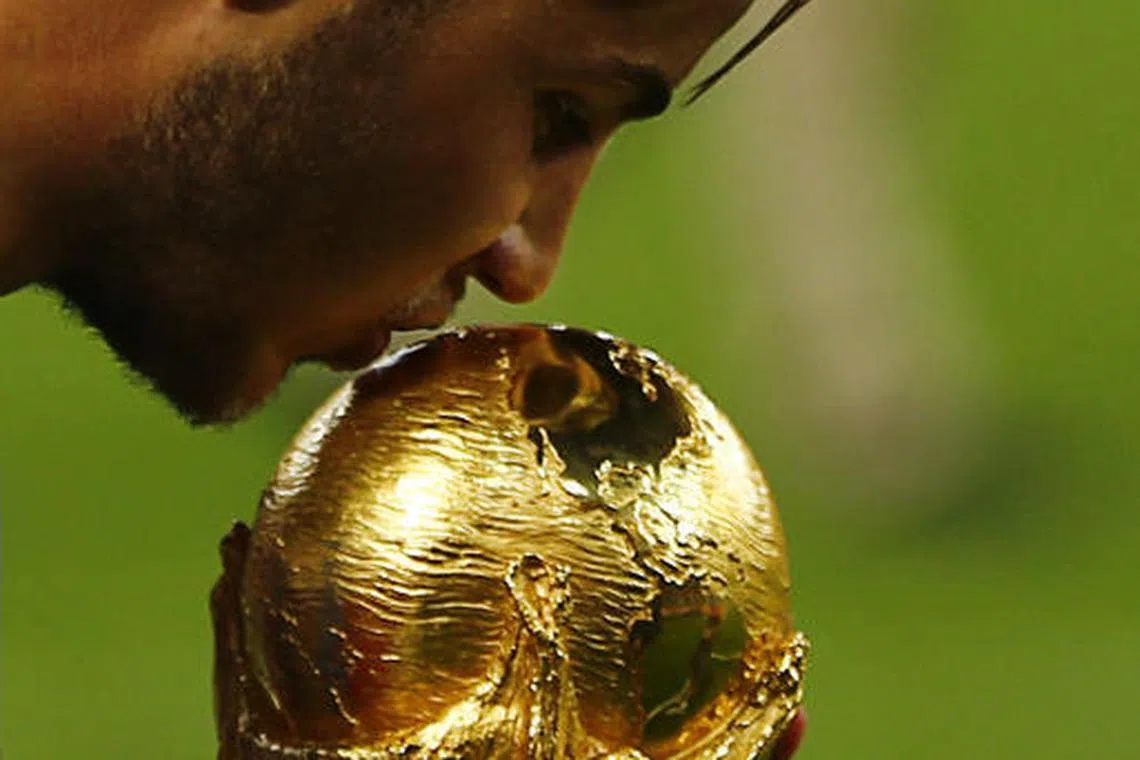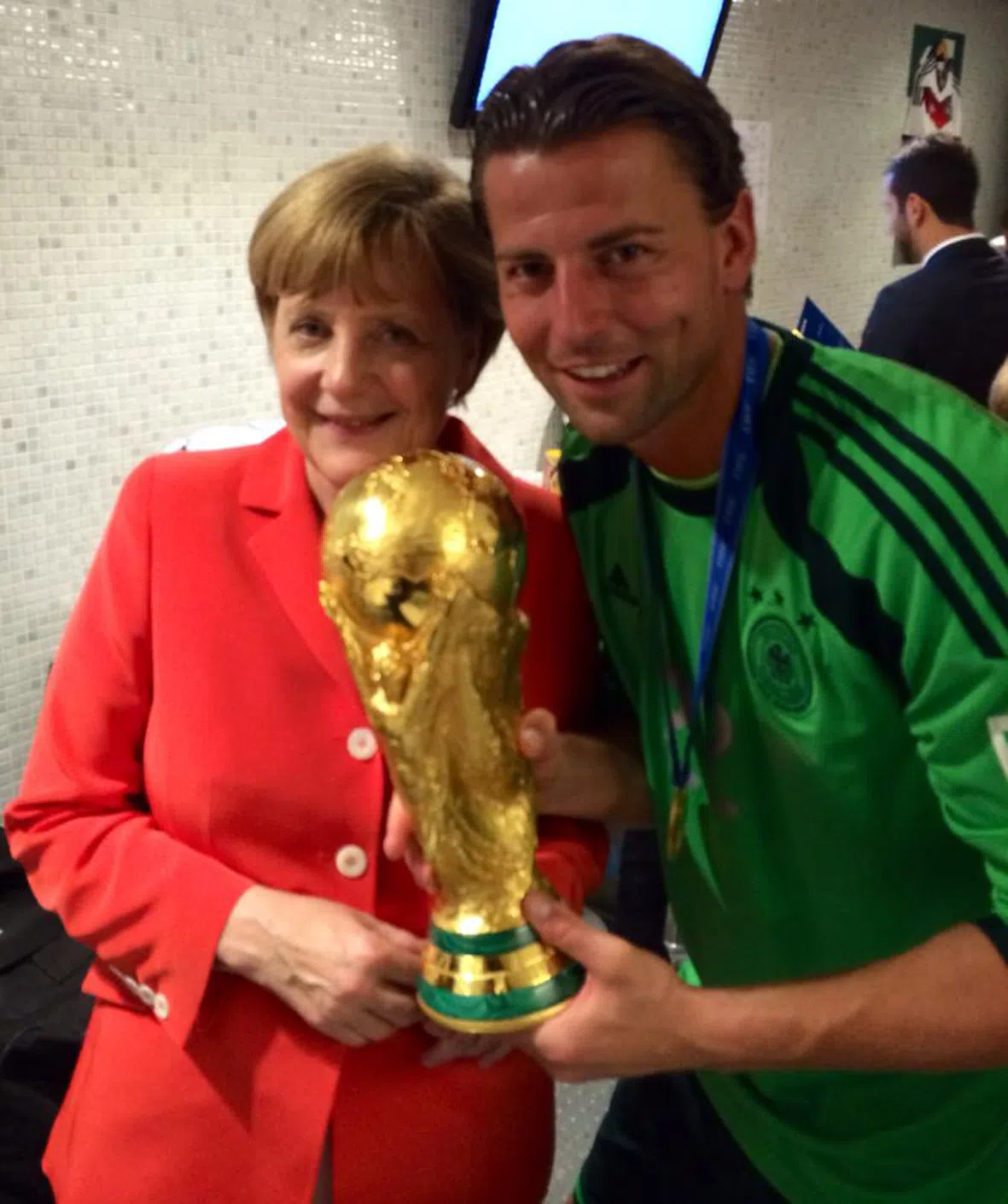Top players describe allure of the World Cup
Sign up now: Get ST's newsletters delivered to your inbox

Mario Gotze kisses the World Cup after his goal in injury time won the championship for Germany in 2014.
PHOTO: REUTERS
Follow topic:
The mere mention of the 2014 World Cup brings a sparkle to Roman Weidenfeller’s eyes. His grin broadens and he leans forward.
“An amazing experience,” says the former Germany goalkeeper. “That was my first time in a big tournament with the national team, and it happened to be in Brazil. And you know what football in Brazil is like. The atmosphere? Fantastic.”
In a nation where football is like religion, Weidenfeller served as back-up to No. 1 Manuel Neuer and did not play a single minute of his team’s triumphant campaign. It does not matter to him.
For he left South America with a very special souvenir in his luggage: A gold medal embossed with the words “WORLD CHAMPION”.
It is a title only 445 players in the 92-year history of the World Cup can lay claim to.
“Not many people even have the chance to actually touch the trophy, you know what I mean?” says the retired Weidenfeller, 42.
Tradition dictates that only champions and heads of state are permitted to touch the 18-carat gold, 6kg, 36cm trophy without gloves.
In fact, winning nations have to return the prize to Fifa for safekeeping after post-final celebrations, and receive a replica to keep instead. Weidenfeller and former German chancellor Angela Merkel – whom he is proudly pictured with along with the trophy – are among a privileged few.
“The World Cup was always a big dream for me,” he says, “and never could I imagine holding the Cup up in the air.”
For many others who do not have that chance, just being on the stage is breathtaking.
Teddy Sheringham, the former England and Manchester United striker, has won Premier League titles, a Champions League, and named Player of the Year in England. The 52-year-old says nothing compares to the feeling of playing at the World Cup.
“You’re that little kid again,” he tells The Straits Times, “standing in line, hearing the national anthem, looking around and thinking: ‘This is what you’ve watched every four years since you were eight years old’.”
“Unreal,” says Andrej Kramaric, part of the Croatia squad that finished runners-up to France in 2018 in Russia.
The striker, who scored in the quarter-final against the hosts, is speaking to a group of international media. He is almost lost in thought as he recounts being away for over 50 days with his teammates, unaware of the impact their run to the final was having back home.
“It was something crazy and it is going to stay forever in our memories. It was maybe the most special moment in my life,” the 31-year-old declares.

Roman Weidenfeller with former German Chancellor Angela Merkel after Germany’s World Cup win in 2014.
Roman Weidenfeller / Facebook
For those from less-established football nations, there is magic and aura around even getting to a World Cup.
It moves the hard-tackling Australian midfielder Cam Devlin close to tears when he receives his call-up from coach Graham Arnold.
Playing at the World Cup, says former United States midfielder Bruce Murray, was a “lifelong dream” and a “real moon shot as a young kid”.
The 56-year-old shares his birthplace of Maryland with Babe Ruth. But, being the son of a Scottish immigrant, he was always going to gravitate towards football and not baseball or gridiron, he explains.
“I never worried about the level of interest (in the country),” says Murray, “since I knew the whole world was watching.”
He went on to play – and score – at the 1990 Finals. But this was three years before Major League Soccer was even founded and the United States team, making their first tournament appearance for 40 years and featuring amateur college players, returned swiftly from Europe after losing all their games.
His goal against Austria was ultimately futile – they were trailing 2-0 and his 83rd-minute strike only reduced the losing margin – so Murray recalls he hardly celebrated the moment. “Sounds a bit crazy telling it,” he admits.
As Boston Red Sox owner John Henry posits in the sports flick Moneyball, though: “The first guy through the wall... he always gets bloody.”
Murray and his teammates’ struggles at Italia ’90 laid the path for the US’ hosting of the 1994 tournament, which catapulted the sport to the mainstream there. He knew, as he put it, that fans in the US would “eventually get on board” with the world’s most popular game.
These days, American players like Christian Pulisic (Chelsea), Weston McKennie (Juventus) and Sergino Dest (AC Milan) are scattered across the world’s top clubs.
Japan winger Kaoru Mitoma, meanwhile, is yet to kick a ball at the World Cup but has already crunched the numbers on how many times he can get on it.
“When I was young, I looked at the World Cup as a dream stage,” the 24-year-old, set to star for the Samurai Blue in Qatar, tells ST. “And considering my age, I think I can play in three World Cups.”
Mitoma, who plays for Premier League club Brighton, can be considered a late bloomer in football. Electing to go to college instead of signing professional terms at 18 meant he made his international debut only in 2021 at age 24.
Whether he – and Japan – make the 2026 and 2030 editions remains to be seen. He will be 33 at the later edition.
That, however, coincidentally was the age Weidenfeller made his first appearance for Germany. A year before he became world champion. And at the World Cup, you are never too old to dream. – Additional reporting by David Lee


